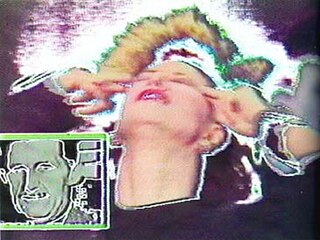Video art is an art form which relies on using video technology as a visual and audio medium. Video art emerged during the late 1960s as new consumer video technology such as video tape recorders became available outside corporate broadcasting. Video art can take many forms: recordings that are broadcast; installations viewed in galleries or museums; works streamed online, distributed as video tapes, or DVDs; and performances which may incorporate one or more television sets, video monitors, and projections, displaying live or recorded images and sounds.

Nam June Paik was a Korean American artist. He worked with a variety of media and is considered to be the founder of video art. He is credited with the first use (1974) of the term "electronic super highway" to describe the future of telecommunications.
Arte is a European public service channel dedicated to culture.

The Player Channel, known as the Poker Channel until 3 December 2012, was a gaming TV network which broadcast to over 30 million households in 30 countries.
Television in Germany began in Berlin on 22 March 1935, broadcasting for 90 minutes three times a week. It was home to the first public television station in the world, named Fernsehsender Paul Nipkow.
A television station is a set of equipment managed by a business, organisation or other entity, such as an amateur television (ATV) operator, that transmits video content and audio content via radio waves directly from a transmitter on the earth's surface to any number of tuned receivers simultaneously.
Welt is a German free-to-air television news channel owned by WeltN24 GmbH. It also provides regular news updates to ProSiebenSat.1 Media properties like ProSieben and kabel eins.

Stan Douglas is an artist based in Vancouver, British Columbia.

Doug Aitken is an American multidisciplinary artist. Aitken's body of work ranges from photography, print media, sculpture, and architectural interventions, to narrative films, sound, single and multi-channel video works, installations, and live performance. He currently lives in Venice, California, and New York City.

"Good Morning, Mr. Orwell" was the first international satellite "installation" by Nam June Paik, a South Korean-born American artist often credited with inventing video art. It occurred on New Year's Day, 1984.

Tele 5 is a German free-to-air television channel that broadcasts classic American films, series, cartoons and Japanese anime.
Magiciens de la Terre was a contemporary art exhibit at the Centre Georges Pompidou and the Grande halle de la Villette from 18 May to 14 August 1989.
Douglas Matthew Davis, Jr. was an American artist, critic, teacher, and writer for among other publications Newsweek.

Cartoon Network is a German pay television channel which primarily broadcasts cartoons. It is based in Munich and is available in Germany, Austria, and Switzerland.

Bahn TV was a television channel owned by Deutsche Bahn, the German state-owned railway company. It started broadcasting in 2001 and closed on 31 December 2010. From February to 31 December 2010 the channel was called DB Bewegtbild.

FS1 is a non-commercial community television channel in Salzburg (Austria). Next to the Community TV okto in Vienna and dorf in Linz, it is the third non-commercial broadcaster with a 24-hour full program in Austria.
Kathy Rae Huffman is an American curator, writer, producer, researcher, lecturer and expert for video and media art. Since the early 1980s, Huffman is said to have helped establish video and new media art, online and interactive art, installation and performance art in the visual arts world. She has curated, written about, and coordinated events for numerous international art institutes, consulted and juried for festivals and alternative arts organisations. Huffman not only introduced video and digital computer art to museum exhibitions, she also pioneered tirelessly to bring television channels and video artists together, in order to show video artworks on TV. From the early 1990s until 2014, Huffman was based in Europe, and embraced early net art and interactive online environments, a curatorial practice that continues. In 1997, she co-founded the Faces mailing list and online community for women working with art, gender and technology. Till today, Huffman is working in the US, in Canada and in Europe.
Madeleine Altmann is a contemporary video artist. She was born in Brazil and lives in the United States.

John Sanborn is a key member of the second wave of American video artists that includes Bill Viola, Gary Hill, Dara Birnbaum and Tony Oursler. Sanborn's body of work spans the early days of experimental video art in the 1970s through the heyday of MTV music/videos and interactive art to digital media art of today.
Livestreamed news refers to live videos streams of television news which are provided via streaming television or via streaming media by various television networks and television news outlets, from various countries. The majority of live news streams are produced as world news broadcasts, by major television networks, or by major news channels; however, there are some live news streams which are produced by individual local television channels as well.









